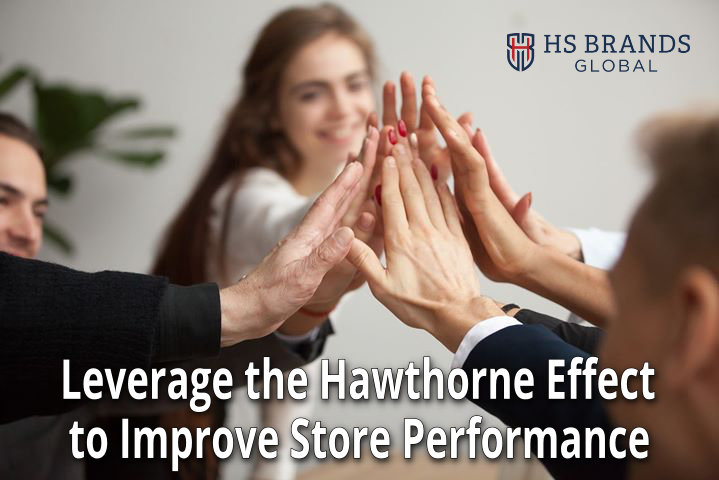
If you’re in sales, raising children, or engage in social media you might find this next statement both bizarre and counter-intuitive: human beings generally want to say “yes.”
It’s true. Humans are social creatures and as such the state of being in harmony with others builds closer ties and greater cooperation. We are literally wired for agreement.
That, of course, doesn’t mean we don’t reject ideas or have differing opinions. It merely means that we are predisposed to find some common ground. Successful negotiators implement this strategy by first finding the places of agreement before tackling the points of contention.
By leveraging the psychological phenomena called the Hawthorne Effect, we can use the human desire for harmony and the advantage of common ground to improve store performance.
Now before you think “harmony” implies some “touchy-feely” group love-in, let me explain that I’m not writing about chakra cleansing or posting “give love a chance” signs.
Nope, researchers discovered the Hawthorne Effect in one of history’s least touchy-feely environments. The factory floor of the 1920’s industrial age.
What is the Hawthorne Effect?
In the early twentieth century, a heightened focus on productivity resulted from changing labor laws, and it ushered in a number of efficiency studies.
As we moved from farming to factory, the connection between “production” and “survival” loosened. A farmer’s desire to avoid starvation motivated him to tend crops, to maintain precise schedules, and to beat the harvest deadlines.
Unlike the farmer, factory workers exchanged their time for money. Whereas a farmer’s output was directly beneficial to his well-being, the factory worker’s output was secondary because it was a means to a paycheck, and the paycheck ultimately purchased things beneficial to his welfare.
Companies recognized the productivity implications created by a pay-for-the-hour system. The possibility of misaligned goals between owner and worker. Whereas the owner wanted maximum hourly output and the worker desired minimum hourly effort.
The Hawthorne Studies, commissioned in the 1920s marked the beginning of the corporate effort to understand how to improve productivity. Over the past century, companies continue to study everything from lighting to workstation layouts, to the motivational impact of free food on worker’s output.
These early studies, however, reached two conclusions that persist today. First, output decreased after forty hours of work. Each additional hour returned less of a return on investment. So our traditional forty-hour work week isn’t a humanitarian effort; it’s based on a financial calculation.
Today, we are beginning to understand that for “brain” work, forty hours may be too much. ( Hopefully, my boss is paying attention to that last statement)
The second conclusion suggested that productivity was related to motivation but not in the way one might think.
The Hawthorne Studies found that increased production was not as simple as systems, processes, and environment. Worker motivation played an equal role in production levels.
Most importantly, the researchers discovered that it didn’t matter what changes were made. Change in itself increased productivity and performance.
The simple act of “paying attention” to employees and letting them know “you were paying attention,” resulted in improvements.
This phenomenon was called the Hawthorne Effect, and the psychological implications were far-reaching. In medicine, clinical trials added control groups and placebo groups to ensure the outcomes weren’t just the results of the Placebo or Hawthorne Effect.
How can we use it to improve performance?
Fortunately, in a store environment, we don’t need to change the physical environment (or provide narcotics) to enjoy the benefits of the Hawthorne Effect. Although environment changes can increase the Hawthorne Effect (like a store remodel), we don’t need to spend money on changing lights, moving counters, or even painting walls.
To take advantage of the Hawthorne Effect, we merely need to introduce a process, state that we believe it will improve “things,” AND communicate that we are watching for the results.
Is it that simple? Where’s the proof?
Well in loss prevention we can look at one such introduction that improved the reduction of loss — the creation of the Target Store program.
Regardless of the name—target, intensive care, focus store, etc.— this program has the two common and necessary elements.
Communication that we are making a change, in this case, a “special” program and two, that we are all paying attention to the results. The exact ingredients needed for the Hawthorne Effect.
Yes, the extra work and effort certainly help make improvements, but we get an even bigger bang for our buck because when employees know our expectations, they tend to work harder to achieve them.
In other words, they pay greater attention to the results and are motivated to perform. Safety managers understand this. That is why those “days without an accident” signs tend to improve safety. It keeps safety practices top of mind and employees know that it is being measured.
Caveat One – It can’t be a secret
The Hawthorne Effect only works when employees are told about the change and that it is being measured. If we implement a new process and don’t demonstrate that we are paying attention to the results, then it won’t act as a motivator.
In those original Hawthorne studies, the study wasn’t a secret. The workers understood that the new lights, the change in processes, the different layouts were all intended to measure for improved performance.
Caveat Two – You can’t set it and forget it
Remember those “days without an accident” signs? The same is necessary for your “test” period. Results, improvements, measurements need to be communicated and the wins require celebration.
The psychology works on the employees’ desires to show it works—that’s the natural desire for agreement and cooperation. If we do things like include a self-audit plan for stores and then pay no attention to their improvement, the Effect of their goodwill dissipates quickly.
Caveat Three – Too much is not a good thing
The Hawthorne Effect has its limits. In the first studies, changes were implemented in small amounts. Although a store remodel tends to improve performance, creating a complex target program with a lot of moving parts won’t work.
The reason is again a matter of psychology. The amount of work to succeed will be judged as more significant than the perceived reward. The Hawthorne Effect is purely a form of psychological motivation.
In our stores, the effect part we want to benefit from is simply a sugar pill.
Again, this effect is separate from the implementation of actual best-practices. It’s merely a plus-one to supercharge our results.
Caveat Four – Lasting results require reinforcement
Over time the benefits will diminish in the same way that the placebo effect of a sugar pill will only make an ill patient feel better for a fixed period. The Hawthorne Effect needs to be reinforced by using that period to create long-term habits. One method is to use its motivational benefits to develop a culture of loss prevention whereas asset protection becomes an ingrained part of employee behavior and the company narrative.
But my employees are grumpy and don’t care
Grumpiness and an uncaring attitude aren’t really employee centered. Those types of feelings are based on company culture. They tend to reflect what the employee believes the employer feels about them.
So, the Hawthorne Effect and the process of using it can improve attitudes by communicating that the company wants to help employees do better. That the employer believes employees want to perform better and that maybe previous low performance owes more to outside factors than employee abilities or efforts.
As noted in the beginning, humans are wired to cooperate and to find agreement. So why not use the benefits of the Hawthorne Effect to give employees the opportunity to deliver that desired cooperation?
———————————————————
Raymond Esposito
Director of Business Development & Marketing
HS Brands Global
Raymond Esposito has over 28 years of loss prevention experience, working within the department store, specialty, and grocery segments of retail. He has developed loss prevention programs for over 125 retailers in the U.S., Canada, and the United Kingdom. He holds a bachelor’s degree in psychology from the University of Connecticut and is an expert witness.
At HS Brands Global we believe that every company needs the four corners of brand protection. Our Brand Shield programs help measure standards and compliance, protect against theft and loss, monitor customer experience, and verify programs and processes.

